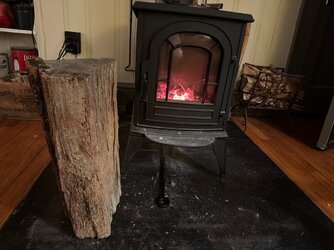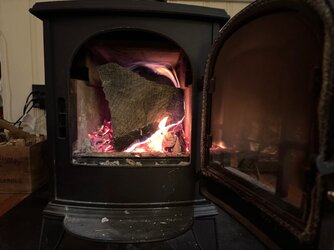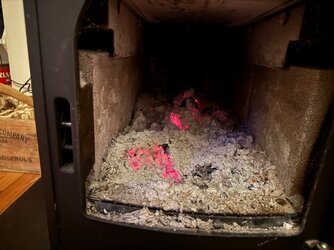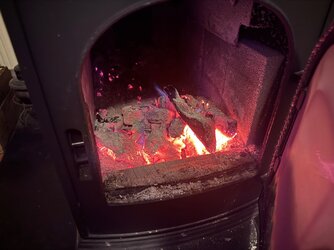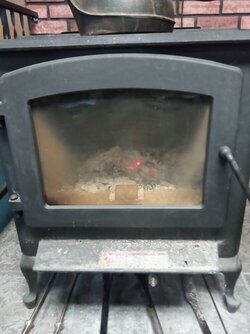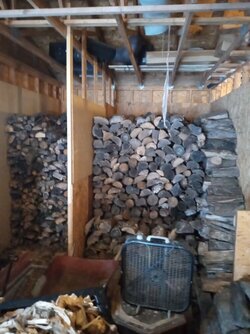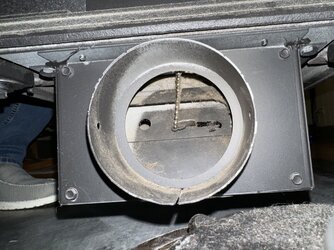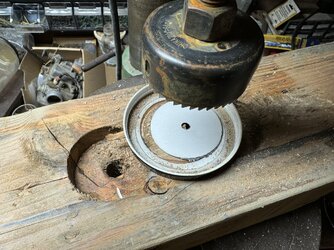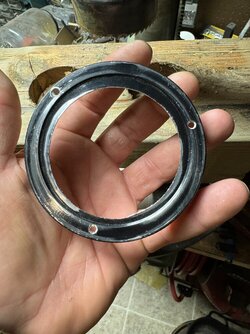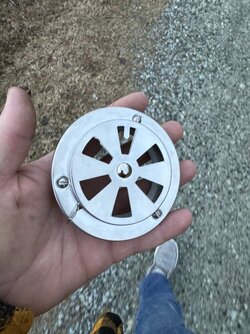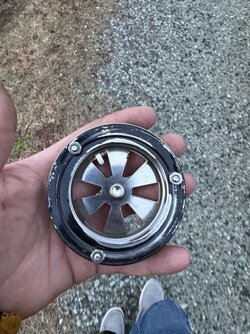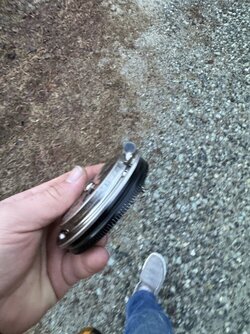It seems the idea behind a damper is to slow the air flow and cool the stove, or keep a stove slow by restricting air before it gets hot. I generally don’t need one on my stove, but have one. Today is the third time I used the damper. I installed it thinking I could slow down a hot fire. However, it seems to do the reverse on a fire that’s getting a little sporty for my tastes.
If I have a fire that’s getting into the mid 600s in the flue, and over 700 STT, I start to watch that one a little closer.
Today I had one that was cruising right along at a pretty good clip.
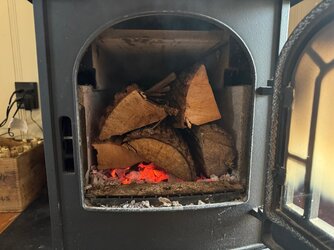
This was the reload. What happened was it got going good enough that it consumed the coals and ashes, and as the coals eroded from the center, it took with it the bottom half of the center log. As the bottom row of logs rolled inwards and locked together forming a makeshift arch, effectively holding itself above the fire brick. The end logs had compressed ashes under the extreme edges, and had a hollow trough down the center. I could look under the burning logs and see clear to the back of the stove.
I could have knocked them down, but what’s the fun in that.
I made three attempts to cool it down. First was the key damper.
I shut the damper down to horizontal, and let it ride a few minutes. The temp steady started to climb faster than it had been. And just kept going up. I opened the damper, and the stove dropped back down to around 630 flue.
Second I put my hand over the intake (OAK) connection. The flames slowed, the secondaries settled down, and I was steady dropping temps. As soon as I removed my hand, it jumped back to life and the temps started climbing back up until it leveled out around 630 flue, 745 STT.
If you watch this video a couple times. First watch the thermometer respond to my hand on the intake. Watch it again and watch the flames settle then jump back up.
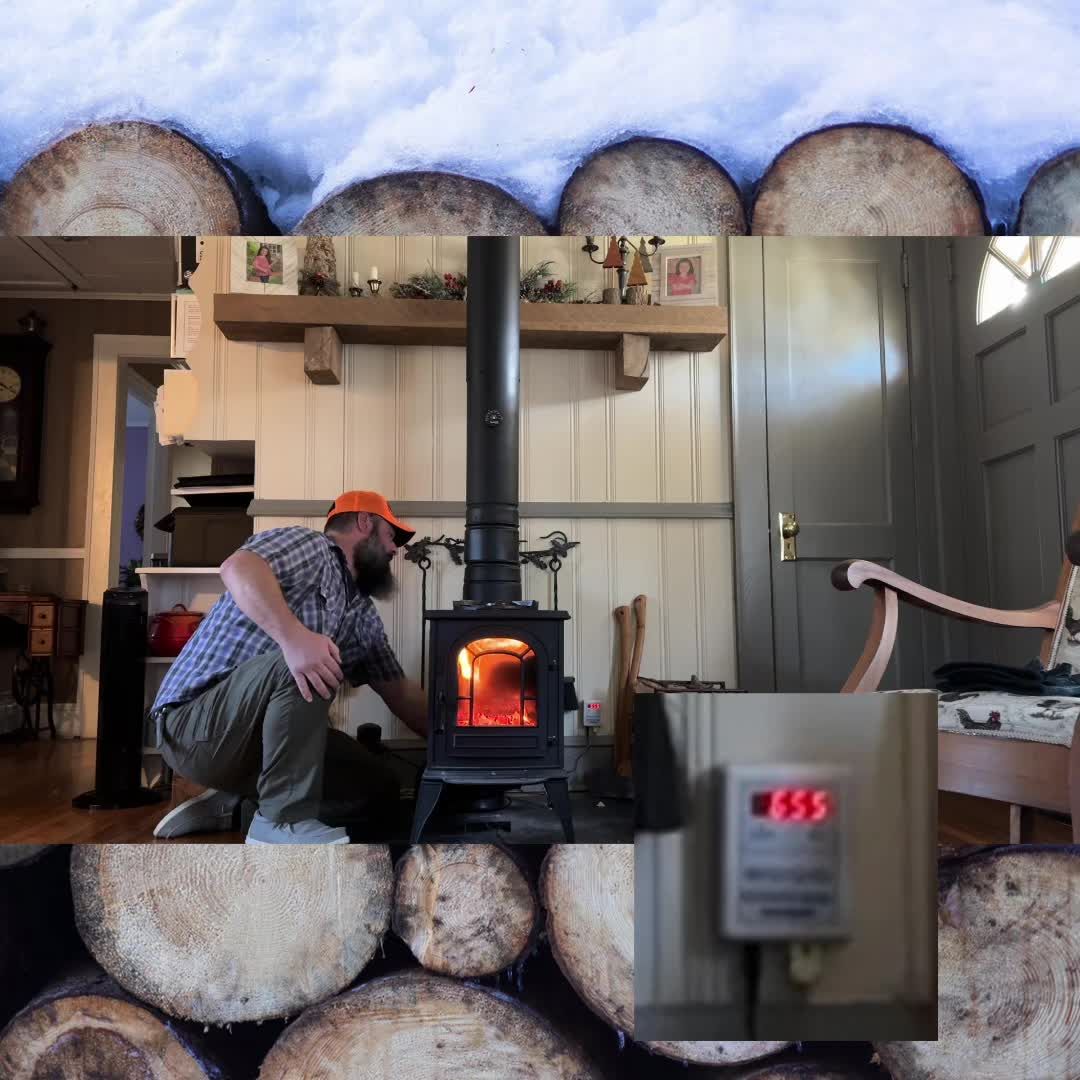
I tried the damper again after the temps had leveled out. I closed the damper and the STT went from 745 to 825. I opened the damper and it all fell back to low 600s flue/750 STT. A couple minutes later the arch collapsed and we settled in.
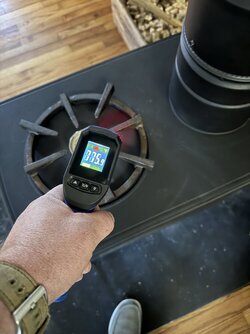
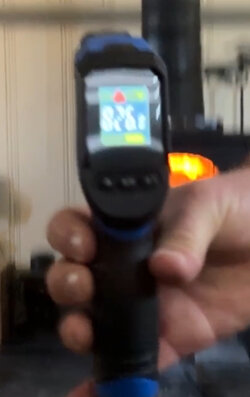
Is this much the same as I hear the cat guys saying to close the air down sooner if folks are having hot stoves. Once it’s hot, shutting down the air/damper won’t really help. If I had shut it down earlier, maybe
It wouldn’t have gassed off that fast. It’s just normally, I dont need to touch anything. My stove doesn’t have controls at all. I added the damper for an emergency brake. Seems like it doesn’t work as that though if it’s already decided to take off. I’ve tried it on three separate occasions. If it’s hot enough I want to slow it down, the damper just makes it hotter.
I’ll be looking for a 3.5” attachment for a damper for the intake. I’ve seen several, but I’m not sure the key damper acts as a brake on something that’s already too hot.
If I have a fire that’s getting into the mid 600s in the flue, and over 700 STT, I start to watch that one a little closer.
Today I had one that was cruising right along at a pretty good clip.

This was the reload. What happened was it got going good enough that it consumed the coals and ashes, and as the coals eroded from the center, it took with it the bottom half of the center log. As the bottom row of logs rolled inwards and locked together forming a makeshift arch, effectively holding itself above the fire brick. The end logs had compressed ashes under the extreme edges, and had a hollow trough down the center. I could look under the burning logs and see clear to the back of the stove.
I could have knocked them down, but what’s the fun in that.
I made three attempts to cool it down. First was the key damper.
I shut the damper down to horizontal, and let it ride a few minutes. The temp steady started to climb faster than it had been. And just kept going up. I opened the damper, and the stove dropped back down to around 630 flue.
Second I put my hand over the intake (OAK) connection. The flames slowed, the secondaries settled down, and I was steady dropping temps. As soon as I removed my hand, it jumped back to life and the temps started climbing back up until it leveled out around 630 flue, 745 STT.
If you watch this video a couple times. First watch the thermometer respond to my hand on the intake. Watch it again and watch the flames settle then jump back up.
I tried the damper again after the temps had leveled out. I closed the damper and the STT went from 745 to 825. I opened the damper and it all fell back to low 600s flue/750 STT. A couple minutes later the arch collapsed and we settled in.


Is this much the same as I hear the cat guys saying to close the air down sooner if folks are having hot stoves. Once it’s hot, shutting down the air/damper won’t really help. If I had shut it down earlier, maybe
It wouldn’t have gassed off that fast. It’s just normally, I dont need to touch anything. My stove doesn’t have controls at all. I added the damper for an emergency brake. Seems like it doesn’t work as that though if it’s already decided to take off. I’ve tried it on three separate occasions. If it’s hot enough I want to slow it down, the damper just makes it hotter.
I’ll be looking for a 3.5” attachment for a damper for the intake. I’ve seen several, but I’m not sure the key damper acts as a brake on something that’s already too hot.
Last edited:


